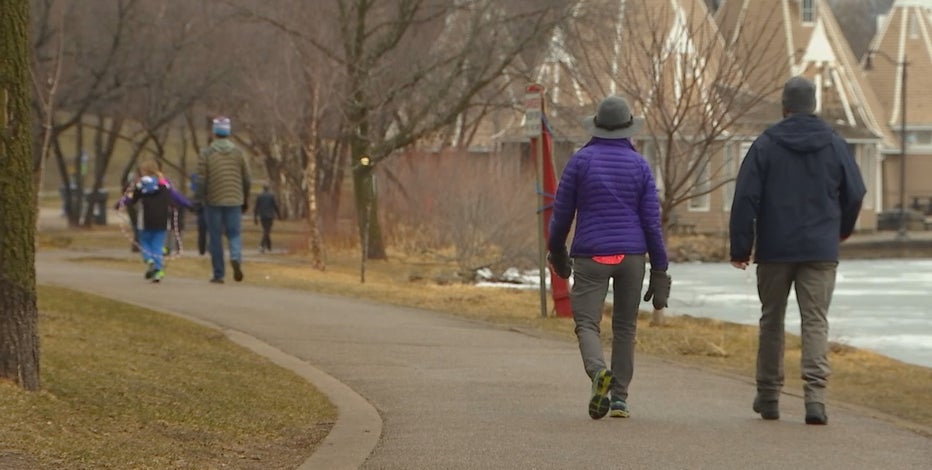Minnesota Gov. Tim Walz issues statewide stay-at-home order amid COVID-19 pandemic
ST. PAUL, Minn. (FOX 9) - UPDATE: The stay-at-home order has been extended to May 4.
Minnesota Gov. Tim Walz has issued a statewide stay-at-home order, joining at least 19 other states, including neighboring Wisconsin, in taking that step to slow the spread of the coronavirus. The governor announced the new restrictions during a 2 p.m. speech televised to the state Wednesday.
The order will be effective from Friday, March 27 through April 10. Minnesotans are being asked to limit movement outside their homes during that time.
Walz said the stay-at-home order will buy the state more time, pushing the peak infection rate out about 14 weeks. He said if there were no mitigation efforts, modeling shows Minnesota would run out of its 235 intensive care unit beds in six weeks. With the order in place, the state will not reach its ICU capacity for 11 weeks.
Related
Buying time: Minnesota Governor explains stay-at-home order using statistical models
Gov. Tim Walz says his newly issued stay-at-home order for the state of Minnesota will reduce physical interaction by 80 percent and buy the state’s health care system “valuable time” to set up more hospital beds.
The order will allow state health officials time to convert arenas and hotel space into hospital units to get enough ventilators to patients that will need them, the governor said.
The order also extends the current restrictions on bars, restaurants and other businesses until May 1. Restaurants and bars will be closed to dine-in customers, but can remain open for takeout. Schools will remain closed until May 4.
“I'm asking you to buckle it up for a few more weeks," Walz told Minnesotans. "Follow the media. Don't trade in theory or innuendo. Try to get the best facts possible.”
What is considered ‘essential’ during shelter at home orders?
States and metropolitan counties across the United States are issuing shelter-in-place orders in an effort to combat the spread of COVID-19 and those orders are creating a clearer picture of what a similar order would look like in Minnesota.
Under the stay-at-home order, Minnesotans may leave their residences only to perform any of the following activities, and while doing so, they should practice social distancing:
- Health and safety activities, such as obtaining emergency services or medical supplies
- Outdoor activities, such as walking, hiking, running, biking, hunting, or fishing
- Necessary Supplies and Services, such as getting groceries, gasoline, or carry-out
- Essential and interstate travel, such as returning to a home from outside this state
- Care of others, such as caring for a family member, friend, or pet in another household
- Displacement, such as moving between emergency shelters if you are without a home
- Relocation to ensure safety, such as relocating to a different location if your home has been unsafe due to domestic violence, sanitation, or essential operations reasons
- Tribal activities and lands, such as activities by members within the boundaries of their tribal reservation
Related
Minnesota stay-at-home order: What you're allowed to do, what's staying open
What does the order mean and what activities are Minnesotans still allowed to do?
Workers who work in critical sectors during this time are exempt from the stay at home order. This includes, but is not limited to, jobs in:
- Healthcare and public health
- Law enforcement, public safety, and first responders
- Emergency shelters, congregate living facilities, drop-in centers
- Child care
- Food and agriculture
- News media
- Energy
- Water and wastewater
- Critical manufacturing
On conference call with reporters Wednesday, the state’s economic development commissioner, Steve Grove, said 78 percent of the jobs in Minnesota are in critical industries as defined by the stay-at-home order.
Grove says an estimated 28 percent of Minnesotans will be temporarily jobless during the two-week order to stay home.
Minnesota Gov. Tim Walz issues statewide stay-at-home order amid COVID-19 pandemic
Minnesota Gov. Tim Walz has issued a statewide stay-at-home order, joining at least 19 other states, including neighboring Wisconsin, in taking that step to slow the spread of the coronavirus. The governor announced the new restrictions during a 2 p.m. speech televised to the state Wednesday.
However, 59 percent of those people will have access to some kind of paid leave. In the past nine days, 64,786 Minnesotans have filed for unemployment.
Walz has called a meeting of the Minnesota Executive Council, a panel of the five statewide elected officials that must approve all new executive orders under the governor's peacetime emergency declaration. That meeting is scheduled for 3:30 p.m. Wednesday.
The number of coronavirus cases in Minnesota surpassed 1,000 on April 7.
For more information and to view the Executive Order, click here.



